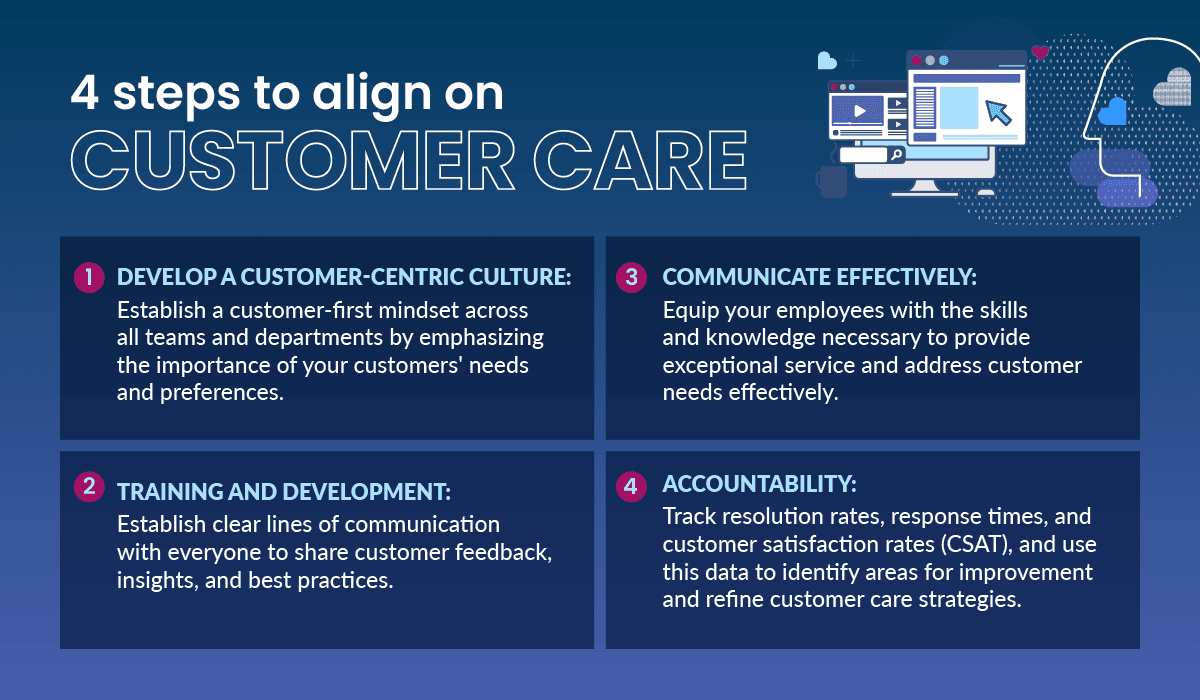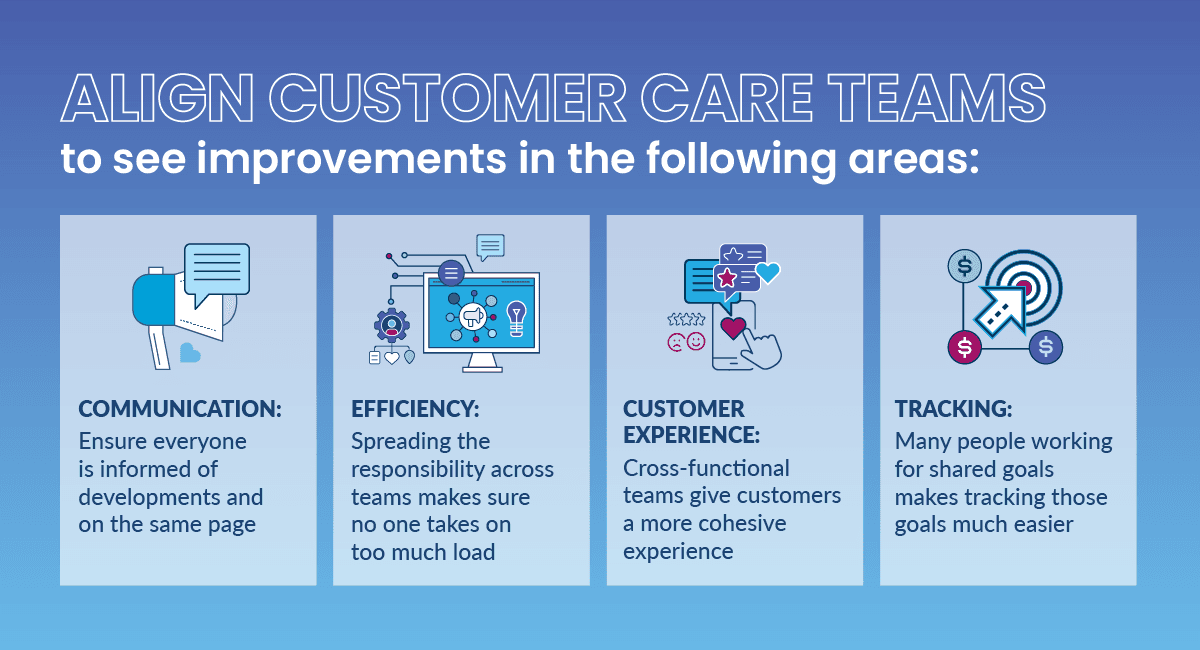In today's hyper-connected world, customer care has become a critical aspect of every business, particularly those in eCommerce. Customers expect to be treated with the utmost care and attention, and any slight misstep can result in negative feedback, a damaged reputation, and/or loss of business.
Customers are more vocal about their customer service dissatisfaction than ever before. A survey found 43% of customers yelled or raised their voice to express displeasure about their most serious problem, up from 35% in 2015. With the rise of social shopping and online review platforms, outraged customers can easily share their negative experiences with a large audience. All it takes is a single negative review or tweet to go viral, after which it can be challenging for brands to control the narrative and bounce back.
To meet the expectations of your customers, brands must align their teams for customer care. This means creating a cohesive and collaborative team that can deliver exceptional customer service consistently. With Emplifi, your company can unlock the power of team alignment to create a seamless customer experience.
Which teams should align on customer care?
From sales to marketing, product development, operations, and customer support, teams should work together to ensure that they are providing the best possible customer experience. This alignment can increase customer loyalty, customer satisfaction, and business growth for your brand.
Here’s how each department can contribute to offering an unforgettable customer experience.
Customer Support: The customer support team is generally the first point of contact for customers who have any questions or issues regarding a purchase. Their role is to solve customers’ inquiries as efficiently as possible.
Marketing: By leveraging marketing data and analytics, the marketing team has insight into customer preferences, expectations, and pain points. They can help companies tailor their customer care strategy to a more personalized approach, offering a positive customer experience.
Sales: The sales team possesses a deep understanding of customer needs, providing accurate information in a timely manner, and offering personalized solutions. This builds trust in your customers that your customer care team is knowledgeable about the product or service, which fosters long-term customer loyalty and business growth.
Product Development: Product teams play a critical role in creating products that meet customer needs and expectations. By gathering customer feedback, conducting user research, and collaborating with other teams, the product team can ensure that the products and services provided to customers are of the highest quality.
Operations: The operations team is responsible for ensuring that the company's processes and procedures are efficient and effective. By aligning with customer care, the team can identify areas where functional improvements can be made to better serve their customers.
4 steps to take to align on customer care

Develop a customer-centric culture: Establish a customer-first mindset across all teams and departments by emphasizing the importance of your customers' needs and preferences, and make sure that every decision and action is aligned with delivering value to those customers.
Communicate effectively: Effective communication is key to ensuring that everyone is on the same page. Teams should also establish clear lines of communication among teams and departments to share customer feedback, insights, and best practices and technology, in order to streamline the entire customer journey.
Training and development: Investing in training and development programs across teams is essential for customer care because it equips employees with the skills and knowledge necessary to provide exceptional service and address customer needs effectively.
Accountability: All teams should have a clear understanding of the company's overall goals and objectives, as well as their role in achieving them. Set metrics to track resolution rates, response times, and customer satisfaction rates (CSAT), and use this data to identify areas for improvement and refine customer care strategies. Teams should then be held accountable for their performance in providing exceptional customer care.
What are some challenges you might run into?
Cross-functional teams may consist of individuals with different backgrounds, skills, and experiences, which can create communication barriers. This can cause misunderstandings and disrupt the customer service process both internally and externally. It can also be challenging to assign clear ownership for specific tasks or issues when there are multiple teams involved in the customer service process. In order to avoid confusion and delays in resolving customer concerns, holding meetings on a consistent basis for stakeholders is crucial to keep everyone informed about the latest happenings, but also to cultivate a sense of shared responsibility. By bringing stakeholders together to conduct regular check-ins, you can ensure that everyone is on the same page and working towards a common goal. This fosters an atmosphere of collaboration and accountability, where everyone is invested in the success of the project or organization. And at the same time allows your staff to focus their efforts on customer care, rather than internal issues.
When working on a customer service process, it's essential to keep the customer's needs and expectations at the forefront. For example, our Emplifi research reveals that 68% of US consumers currently use, or would like to use, social media to engage with brands to ask questions before making a purchase, while 59% of consumers expect to do so to get post-purchase customer support. The rise of social commerce, along with the Millennial and Gen Z shopper, has created the need for brands to implement a social media customer service strategy to serve customers exactly where they are. However, implementing new changes and trends to the customer service process can be met with resistance from team members who may be comfortable with the current process. This can slow down and hinder the effectiveness of the cross-functional team.
Benefits of aligning teams on customer care

Aligning teams on customer care can take your brand to the next level by creating a competitive advantage that sets you apart from the rest. A study showed 83% of “digitally maturing” companies reported using cross-functional teams, compared to 71% of “developing” companies and 55% of companies that are “early stage” on the digital maturity spectrum. When all teams within a company are working toward the same goal of delivering exceptional customer experiences, it creates an innovative environment with different perspectives and creative solutions, ultimately driving business growth.
Implementing a streamlined customer service process fosters a customer-centric culture where everyone works toward a common objective. Which, in this case, is delivering exceptional customer care. Not only will you see a positive change in your customers' behavior, but your employees' as well. This cross-collaboration can lead to greater employee satisfaction and retention, as employees feel a greater sense of purpose and pride in delivering quality service to customers. By successfully aligning teams on customer care, you’ll begin to see improvements in the following areas:
Communication: Clear and timely communication within a team helps to ensure that everyone is aware of the current status of projects and any changes in the organization or process. This way team members can make informed decisions and work collaboratively toward achieving organizational objectives on customer care.
Efficiency: When an organization operates efficiently, it means that tasks are completed quickly and accurately, thanks to clear processes and procedures. This helps everyone involved to know exactly how and when to act, which keeps the work flowing smoothly and avoid any oversight.
Customer experience: By ensuring that all teams in a company work towards a common goal of delivering a great customer experience, you can streamline the entire process across channels. Essentially creating a more cohesive and enjoyable experience for the customer.
Tracking: When everyone is using the same playbook, it becomes much easier to measure results and ensure that all customers are receiving the same high-quality care.
The takeaway
In today's fast-paced and competitive business environment, aligning teams on customer care is more important than ever. It’s important to note that aligning teams on customer care isn’t just about delivering great service, but about creating a culture of excellence that promotes success and helps companies stand out in the marketplace.
In addition to aligning your teams towards a common goal, having the right tools is equally important for providing excellent customer care. With the right technology, your teams can better understand your customers and provide personalized experiences across all touchpoints.
The right customer experience platform should help brands better understand customers as they navigate their journeys. Aim for excellence by combining the power of aligned teams and the right tools to improve customer care experiences across different channels and enable your brand to stand out from the crowd as a CX leader.
Book a demo today to see how Emplifi can help.
























